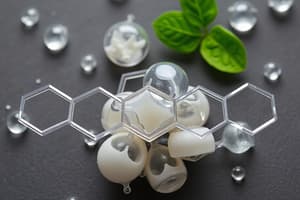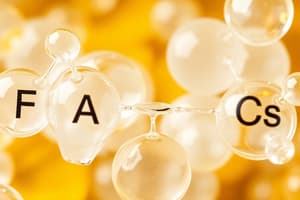Podcast
Questions and Answers
What is the term used to describe fatty acids with double bonds?
What is the term used to describe fatty acids with double bonds?
- Saturated
- Polyunsaturated
- Hydrogenated
- Unsaturated (correct)
What is the effect of double bonds on the melting points of fatty acids?
What is the effect of double bonds on the melting points of fatty acids?
- Varies depending on the type of fatty acid
- Has no effect on the melting points
- Decreases the melting points (correct)
- Increases the melting points
What is the term used to describe fatty acids that cannot be synthesized by the body?
What is the term used to describe fatty acids that cannot be synthesized by the body?
- Unsaturated fatty acids
- Omega-3 fatty acids
- Saturated fatty acids
- Essential fatty acids (correct)
What is the shorthand representation of the fatty acid oleic acid?
What is the shorthand representation of the fatty acid oleic acid?
What is the symbol used to indicate the site of unsaturation in a fatty acid?
What is the symbol used to indicate the site of unsaturation in a fatty acid?
What is the term used to describe fatty acids with multiple double bonds?
What is the term used to describe fatty acids with multiple double bonds?
What is the shorthand representation of the fatty acid arachidonic acid?
What is the shorthand representation of the fatty acid arachidonic acid?
What is the term used to describe the system used to describe the site of unsaturation in a fatty acid?
What is the term used to describe the system used to describe the site of unsaturation in a fatty acid?
What is the main reason lipids are insoluble in water?
What is the main reason lipids are insoluble in water?
What is the energy value of 1 gram of fat?
What is the energy value of 1 gram of fat?
What is the function of lipids in membrane structure?
What is the function of lipids in membrane structure?
What type of fatty acid has multiple sites of unsaturation?
What type of fatty acid has multiple sites of unsaturation?
What is the typical number of carbons in a fatty acid?
What is the typical number of carbons in a fatty acid?
What is the characteristic of the hydrocarbon tail in fatty acids?
What is the characteristic of the hydrocarbon tail in fatty acids?
What is the function of lipids in cellular metabolism?
What is the function of lipids in cellular metabolism?
What is the characteristic of saturated fatty acids?
What is the characteristic of saturated fatty acids?
Flashcards are hidden until you start studying
Study Notes
Lipids
- Lipids are hydrophobic, nonpolar molecules, soluble in nonpolar solvents and insoluble in polar solvents like water.
Fatty Acids
- Fatty acids belong to the carboxylic acid family and contain a carboxylic acid group, making them polar.
- They also have a long hydrocarbon tail, making them nonpolar overall.
- Fatty acids typically contain between 12 and 20 carbon atoms, usually an even number.
- Fatty acids with no carbon-carbon double bonds are saturated, while those with double bonds are unsaturated, and those with multiple sites of unsaturation are polyunsaturated (PUFAs).
Properties of Fatty Acids
- Melting points of saturated fatty acids increase with the number of carbon atoms.
- Unsaturation lowers the melting points of fatty acids due to the cis configuration of double bonds.
- The common fatty acids found in biological systems are shown in Table 8.1 of Raymond.
Essential Fatty Acids
- Essential fatty acids (EFAs) are unsaturated fatty acids that cannot be synthesized by the body and must be supplied in the diet.
- Examples of EFAs include linoleic acid, linolenic acid, and arachidonic acid.
Representation of Fatty Acids
- The shorthand representation of fatty acids includes the total number of carbon atoms, the number of double bonds, and the position of double bonds, starting from the carboxyl end.
- Examples of shorthand representation include palmitic acid (16:0), oleic acid (18:1:9), and arachidonic acid (20:4;5,8,11,14).
Delta System
- The site of unsaturation in a fatty acid is indicated by the symbol Δ and the number of the first carbon of the double bond relative to the carboxylic acid group (–COOH).
- Example: palmitoleic acid is designated as 16:1Δ9, indicating a 16-carbon fatty acid with one site of unsaturation between carbons 9 and 10.
Function of Lipids
- Lipids are a source of high energy value (1 gram = 9 calories).
- Lipids are constituents of membrane structure and regulate membrane permeability.
- Lipids serve as a source of fat-soluble vitamins (A, D, K, and E).
- Lipids are important as cellular metabolic regulators (steroid hormones and prostaglandins).
- Lipids (phospholipids) participate in the electron transport chain in the inner mitochondrial membranes.
Studying That Suits You
Use AI to generate personalized quizzes and flashcards to suit your learning preferences.




